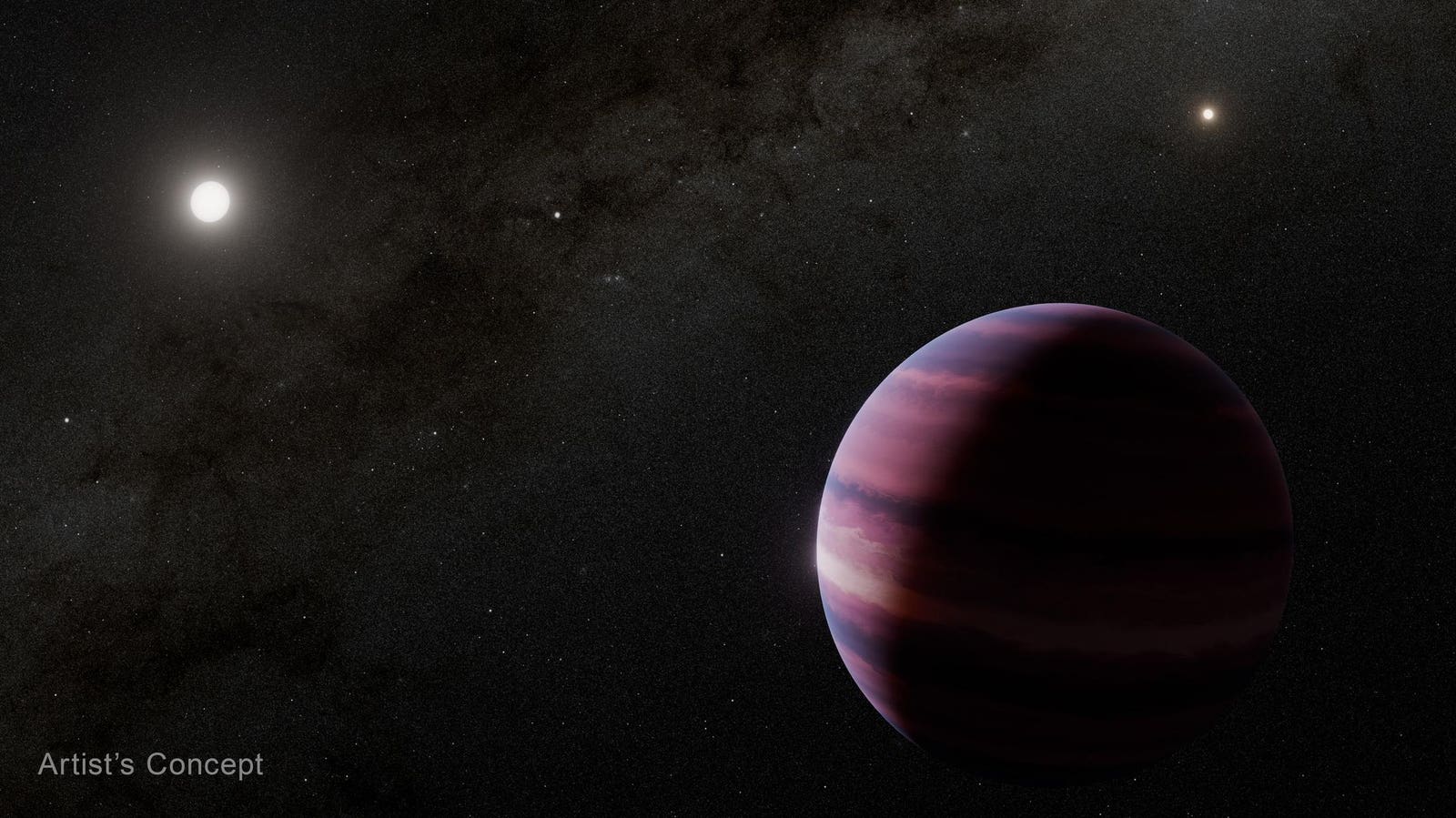This artist’s concept shows what a gas giant orbiting Alpha Centauri A could look like. Observations of the triple star system Alpha Centauri using NASA’s James Webb Space Telescope indicate the potential gas giant, about the mass of Saturn, orbiting the star by about two times the distance between the Sun and Earth. In this concept, Alpha Centauri A is depicted at the upper left of the planet, while the other Sun-like star in the system, Alpha Centauri B, is at the upper right. Our Sun is shown as a small dot of light between those two stars.
NASA, ESA, CSA, STScI, Robert L. Hurt (Caltech/IPAC)
Today astronomers announced the likely discovery of an exoplanet in the Alpha Centauri system that is almost certain to be among the first beyond our solar system to be visited by humans – or at least passed by human-made robots.
NASA’s James Webb Space Telescope spotted “strong evidence” of a roughly Saturn-sized gas giant orbiting Alpha Centauri A, one of the trio of stars making up Alpha Centauri, the closest set of stars to Earth beyond our own sun.
The findings will be published in a pair of upcoming papers in The Astrophysical Journal Letters.
While the planet orbits in the habitable zone, the extreme environment found on gas giant planets is not thought to host life as we know it.
We could still be witnessing the process of science fiction turning into science fact, however. Numerous works of science fiction have been set in the Alpha Centauri system, including the blockbuster Avatar franchise, which is set largely on a moon orbiting a giant planet not unlike the one researchers suspect they’ve found.
Observations of the Alpha Centauri triple star system: From left, the ground-based Digitized Sky Survey shows all three stars as a single source of light; NASA’s Hubble resolves two Sun-like stars; the MIRI instrument on NASA’s Webb blocks the bright glare from one star, revealing a potential planet.
NASA, ESA, CSA, Aniket Sanghi (Caltech), Chas Beichman (NExScI, NASA/JPL-Caltech), Dimitri Mawet (Caltech), Joseph DePasquale (STScI)
Not Officially an Exoplanet Just Yet
The possible planet is still technically a planet “candidate,” but if confirmed it would be the closest to its host star to ever be directly imaged, as well as the first around a star that is very similar to our sun in terms of age and temperature.
Directly imaging a star is what it sounds like: directly observing light from the planet using a telescope or other instrument. But this isn’t how many exoplanets are discovered. Many distant worlds have been found by observing how they impact the brightness or even the “wobble” of a star as they orbit. Closer stars are better candidates for direct imaging, which also allows scientists to study the worlds in greater depth.
“With this system being so close to us, any exoplanets found would offer our best opportunity to collect data on planetary systems other than our own. Yet, these are incredibly challenging observations to make, even with the world’s most powerful space telescope, because these stars are so bright, close, and move across the sky quickly,” said Charles Beichman from NASA’s Jet Propulsion Laboratory, who is also co-first author on the new papers, in a statement.
Three planets have been found around the dwarf planet Proxima Centauri, by far the smallest and dimmest of the stellar threesome. The much greater size and brightness of the other two stars have made it difficult to spot planets in their orbits. But by using Webb’s Mid-Infrared Instrument (MIRI), along with detailed analysis and computer modeling, researchers ruled out other explanations – such as a background galaxy, asteroid or image artifact – for the object seen in observations.
“Webb was designed and optimized to find the most distant galaxies in the universe. The operations team at the Space Telescope Science Institute had to come up with a custom observing sequence just for this target, and their extra effort paid off spectacularly,” Beichman explained.
A New Understanding for Exoplanets
While not habitable, the lure of such a new planet – not to mention its neighbors around Proxima Centauri and others still waiting to be found – is likely to be irresistible to scientists and even those with a basic curiosity about the cosmos.
“Its very existence in a system of two closely separated stars would challenge our understanding of how planets form, survive, and evolve in chaotic environments,” said CalTech Ph.D. student Aniket Sanghi, a co-author on the papers.
At only four light years away, it’s at least theoretically possible that some sort of craft could travel there from Earth in under a decade. The closest thing proposed so far is the Breakthrough Starshot mission that would send a small probe to the system using a laser probe, taking about 25 years to reach its target.
As for sending actual people to explore the system, the Chrysalis multi-generational ship proposes taking less than 400 years to make the trip, transporting over 1,000 people on a city-sized craft. The very hypothetical concept recently won the Project Hyperion design contest.
But first, scientists will check again to make sure the planet candidate does in fact exist. Future observations are planned by the Webb telescope as well as NASA’s Nancy Grace Roman Space Telescope, expected to launch in 2027.









